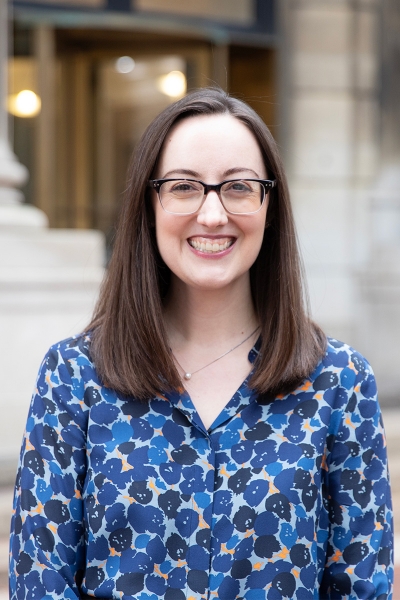
Emma Asher
In this series, we speak with professors who lead different sections of the Core Curriculum to learn what they love about engaging with College students. This month we chat about Music Humanities with Julia Doe, associate professor of music, historical musicology; Doe specializes in the music, literature and politics of 18th-century France and has taught Music Hum for nearly a decade.
What is the best part about teaching the Core Curriculum?
I find Music Humanities exciting to teach because this course — perhaps even more than others in the Core — introduces a skill set and a way of approaching works of art that might initially be unfamiliar to students. For example, students might not have read the specific texts covered in Lit Hum, but they have likely come into a class with experience analyzing other pieces of literature. By comparison, students tend to have less prior knowledge of techniques of critical listening, even if they have undoubtedly spent a lot of time listening to music outside of the academic domain. Music Hum represents an exciting challenge for me because we get to build expertise together, which can lead to a lot of rewarding light-bulb moments. A composition like Beethoven’s 5th Symphony, perhaps the best-known work in Music Hum, is ubiquitous in popular culture but, I would venture, becomes vastly more interesting with an understanding of the technical means of its construction and the aesthetic context of its creation. And that kind of auditory attention is really transferable beyond the classroom. Sometimes students have noticed that after Music Hum, they have trouble putting on passive background music in the same manner they used to because their modes of engagement have changed. I take that as a compliment.
How do you put your own spin on teaching Music Humanities?
It’s an explicit goal of the Music Hum syllabus that the course engages the artistic resources of New York City. But my students might say I follow through on that ideal to an especially enthusiastic degree; I’m making up for lost time after Covid-19! In recent semesters, my class has completed assignments in the musical instrument collection at the Metropolitan Museum of Art, we have gone to many concerts at Carnegie Hall and at Lincoln Center and we’ve even taken immersive soundwalks in Central Park, an app-based musical initiative put together by composer Ellen Reid [’05] and performers from the New York Philharmonic.
At Columbia we also have an impressive array of resources even closer to home. I think a real joy of this course is to introduce students to or to remind students of the talents of their peers on campus. Final projects in my section of Music Hum occasionally revolve around end-of-term presentations from the Columbia Music Performance Program. It can be so helpful to have live performers in class, whether a solo pianist or a jazz ensemble, to demonstrate concepts in conjunction with our discussions — we’re really lucky to have all sorts of talent around us.
Are you teaching anything either this semester or next semester that you feel is especially relevant for this moment in time?
During the course of a semester, we spend a lot of time listening critically to music, as well as thinking critically about what it means to listen to music. We interrogate the political ends to which music has been deployed, and the ideological ramifications of the histories we are constructing around musical works. But at the same time, I think it’s not too trite to also place an emphasis on the aesthetic pleasure that these repertoires might impart. Students will often mention leaving the course with a few favored tracks on repeat, perhaps the final scene of absolution in Mozart’s Marriage of Figaro, or the really gorgeous slow movement of Clara Schumann’s Piano Trio. I think a lot about how Columbia can be such an intense and fast-paced institution, so I’m glad that studying for Music Hum can provide spaces for respite alongside spaces for growth.
What has been your favorite Core Curriculum teaching moment?
One of the defining features of music as an art form is the communal way in which we experience it. Put differently, many pieces of music depend not simply on the interaction of a creator and a solitary consumer, but also on this broader triangulation of author, performers and audience. So the highlight of the semester for me is almost always the trip to the Metropolitan Opera. With hundreds of students in attendance, Columbia basically stages a takeover of the top rungs of the theater to see Puccini’s La bohème or Verdi’s La traviata or, recently, Blanchard’s Champion. This is a fun social occasion, but also an opportunity to reflect on what it means to share an artistic experience in real time and in person with those around us. We will have watched a recording of the opera in question in advance of the performance. Students have very smart observations about the differences between the live and the digitized version of the work, and the trade-offs between accessibility and immersion raised through these diverse means of consuming music. And I think — especially coming out of years of schooling impacted by the pandemic — taking in this massive musical spectacle in a packed house full of spectators and in our best fancy outfits is not something we take for granted.